+ Open data
Open data
- Basic information
Basic information
| Entry | Database: EMDB / ID: EMD-25125 | |||||||||
|---|---|---|---|---|---|---|---|---|---|---|
| Title | Cryo-EM structure of human GPR158 | |||||||||
 Map data Map data | ||||||||||
 Sample Sample |
| |||||||||
| Function / homology |  Function and homology information Function and homology informationG protein-coupled glycine receptor activity / regulation of G protein-coupled receptor signaling pathway / positive regulation of neurotransmitter secretion / regulation of synapse organization / protein localization to plasma membrane / cell projection / enzyme activator activity / postsynaptic density membrane / brain development / cognition ...G protein-coupled glycine receptor activity / regulation of G protein-coupled receptor signaling pathway / positive regulation of neurotransmitter secretion / regulation of synapse organization / protein localization to plasma membrane / cell projection / enzyme activator activity / postsynaptic density membrane / brain development / cognition / transmembrane signaling receptor activity / presynaptic membrane / postsynaptic membrane / G protein-coupled receptor signaling pathway / nucleus / plasma membrane Similarity search - Function | |||||||||
| Biological species |  Homo sapiens (human) Homo sapiens (human) | |||||||||
| Method | single particle reconstruction / cryo EM / Resolution: 3.4 Å | |||||||||
 Authors Authors | Patil DN / Singh S / Singh AK / Martemyanov KA | |||||||||
| Funding support |  United States, 1 items United States, 1 items
| |||||||||
 Citation Citation |  Journal: Science / Year: 2022 Journal: Science / Year: 2022Title: Cryo-EM structure of human GPR158 receptor coupled to the RGS7-Gβ5 signaling complex. Authors: Dipak N Patil / Shikha Singh / Thibaut Laboute / Timothy S Strutzenberg / Xingyu Qiu / Di Wu / Scott J Novick / Carol V Robinson / Patrick R Griffin / John F Hunt / Tina Izard / Appu K Singh ...Authors: Dipak N Patil / Shikha Singh / Thibaut Laboute / Timothy S Strutzenberg / Xingyu Qiu / Di Wu / Scott J Novick / Carol V Robinson / Patrick R Griffin / John F Hunt / Tina Izard / Appu K Singh / Kirill A Martemyanov /    Abstract: GPR158 is an orphan G protein–coupled receptor (GPCR) highly expressed in the brain, where it controls synapse formation and function. GPR158 has also been implicated in depression, carcinogenesis, ...GPR158 is an orphan G protein–coupled receptor (GPCR) highly expressed in the brain, where it controls synapse formation and function. GPR158 has also been implicated in depression, carcinogenesis, and cognition. However, the structural organization and signaling mechanisms of GPR158 are largely unknown. We used single-particle cryo–electron microscopy (cryo-EM) to determine the structures of human GPR158 alone and bound to an RGS signaling complex. The structures reveal a homodimeric organization stabilized by a pair of phospholipids and the presence of an extracellular Cache domain, an unusual ligand-binding domain in GPCRs. We further demonstrate the structural basis of GPR158 coupling to RGS7-Gβ5. Together, these results provide insights into the unusual biology of orphan receptors and the formation of GPCR-RGS complexes. | |||||||||
| History |
|
- Structure visualization
Structure visualization
| Movie |
 Movie viewer Movie viewer |
|---|---|
| Structure viewer | EM map:  SurfView SurfView Molmil Molmil Jmol/JSmol Jmol/JSmol |
| Supplemental images |
- Downloads & links
Downloads & links
-EMDB archive
| Map data |  emd_25125.map.gz emd_25125.map.gz | 228 MB |  EMDB map data format EMDB map data format | |
|---|---|---|---|---|
| Header (meta data) |  emd-25125-v30.xml emd-25125-v30.xml emd-25125.xml emd-25125.xml | 13.4 KB 13.4 KB | Display Display |  EMDB header EMDB header |
| Images |  emd_25125.png emd_25125.png | 56.9 KB | ||
| Archive directory |  http://ftp.pdbj.org/pub/emdb/structures/EMD-25125 http://ftp.pdbj.org/pub/emdb/structures/EMD-25125 ftp://ftp.pdbj.org/pub/emdb/structures/EMD-25125 ftp://ftp.pdbj.org/pub/emdb/structures/EMD-25125 | HTTPS FTP |
-Validation report
| Summary document |  emd_25125_validation.pdf.gz emd_25125_validation.pdf.gz | 442.5 KB | Display |  EMDB validaton report EMDB validaton report |
|---|---|---|---|---|
| Full document |  emd_25125_full_validation.pdf.gz emd_25125_full_validation.pdf.gz | 442.1 KB | Display | |
| Data in XML |  emd_25125_validation.xml.gz emd_25125_validation.xml.gz | 7.2 KB | Display | |
| Data in CIF |  emd_25125_validation.cif.gz emd_25125_validation.cif.gz | 8.2 KB | Display | |
| Arichive directory |  https://ftp.pdbj.org/pub/emdb/validation_reports/EMD-25125 https://ftp.pdbj.org/pub/emdb/validation_reports/EMD-25125 ftp://ftp.pdbj.org/pub/emdb/validation_reports/EMD-25125 ftp://ftp.pdbj.org/pub/emdb/validation_reports/EMD-25125 | HTTPS FTP |
-Related structure data
| Related structure data |  7sheMC  7shfC C: citing same article ( M: atomic model generated by this map |
|---|---|
| Similar structure data |
- Links
Links
| EMDB pages |  EMDB (EBI/PDBe) / EMDB (EBI/PDBe) /  EMDataResource EMDataResource |
|---|---|
| Related items in Molecule of the Month |
- Map
Map
| File |  Download / File: emd_25125.map.gz / Format: CCP4 / Size: 244.1 MB / Type: IMAGE STORED AS FLOATING POINT NUMBER (4 BYTES) Download / File: emd_25125.map.gz / Format: CCP4 / Size: 244.1 MB / Type: IMAGE STORED AS FLOATING POINT NUMBER (4 BYTES) | ||||||||||||||||||||||||||||||||||||||||||||||||||||||||||||||||||||
|---|---|---|---|---|---|---|---|---|---|---|---|---|---|---|---|---|---|---|---|---|---|---|---|---|---|---|---|---|---|---|---|---|---|---|---|---|---|---|---|---|---|---|---|---|---|---|---|---|---|---|---|---|---|---|---|---|---|---|---|---|---|---|---|---|---|---|---|---|---|
| Projections & slices | Image control
Images are generated by Spider. | ||||||||||||||||||||||||||||||||||||||||||||||||||||||||||||||||||||
| Voxel size | X=Y=Z: 0.873 Å | ||||||||||||||||||||||||||||||||||||||||||||||||||||||||||||||||||||
| Density |
| ||||||||||||||||||||||||||||||||||||||||||||||||||||||||||||||||||||
| Symmetry | Space group: 1 | ||||||||||||||||||||||||||||||||||||||||||||||||||||||||||||||||||||
| Details | EMDB XML:
CCP4 map header:
| ||||||||||||||||||||||||||||||||||||||||||||||||||||||||||||||||||||
-Supplemental data
- Sample components
Sample components
-Entire : Receptor
| Entire | Name: Receptor |
|---|---|
| Components |
|
-Supramolecule #1: Receptor
| Supramolecule | Name: Receptor / type: complex / ID: 1 / Parent: 0 / Macromolecule list: #1 |
|---|---|
| Source (natural) | Organism:  Homo sapiens (human) Homo sapiens (human) |
| Recombinant expression | Organism:  Homo sapiens (human) Homo sapiens (human) |
| Molecular weight | Theoretical: 170 KDa |
-Macromolecule #1: G-protein coupled receptor 158
| Macromolecule | Name: G-protein coupled receptor 158 / type: protein_or_peptide / ID: 1 / Number of copies: 2 / Enantiomer: LEVO |
|---|---|
| Source (natural) | Organism:  Homo sapiens (human) Homo sapiens (human) |
| Molecular weight | Theoretical: 88.251633 KDa |
| Recombinant expression | Organism:  Homo sapiens (human) Homo sapiens (human) |
| Sequence | String: MGAMAYPLLL CLLLAQLGLG AVGASRDPQG RPDSPRERTP KGKPHAQQPG RASASDSSAP WSRSTDGTIL AQKLAEEVPM DVASYLYTG DSHQLKRANC SGRYELAGLP GKWPALASAH PSLHRALDTL THATNFLNVM LQSNKSREQN LQDDLDWYQA L VWSLLEGE ...String: MGAMAYPLLL CLLLAQLGLG AVGASRDPQG RPDSPRERTP KGKPHAQQPG RASASDSSAP WSRSTDGTIL AQKLAEEVPM DVASYLYTG DSHQLKRANC SGRYELAGLP GKWPALASAH PSLHRALDTL THATNFLNVM LQSNKSREQN LQDDLDWYQA L VWSLLEGE PSISRAAITF STDSLSAPAP QVFLQATREE SRILLQDLSS SAPHLANATL ETEWFHGLRR KWRPHLHRRG PN QGPRGLG HSWRRKDGLG GDKSHFKWSP PYLECENGSY KPGWLVTLSS AIYGLQPNLV PEFRGVMKVD INLQKVDIDQ CSS DGWFSG THKCHLNNSE CMPIKGLGFV LGAYECICKA GFYHPGVLPV NNFRRRGPDQ HISGSTKDVS EEAYVCLPCR EGCP FCADD SPCFVQEDKY LRLAIISFQA LCMLLDFVSM LVVYHFRKAK SIRASGLILL ETILFGSLLL YFPVVILYFE PSTFR CILL RWARLLGFAT VYGTVTLKLH RVLKVFLSRT AQRIPYMTGG RVMRMLAVIL LVVFWFLIGW TSSVCQNLEK QISLIG QGK TSDHLIFNMC LIDRWDYMTA VAEFLFLLWG VYLCYAVRTV PSAFHEPRYM AVAVHNELII SAIFHTIRFV LASRLQS DW MLMLYFAHTH LTVTVTIGLL LIPKFSHSSN NPRDDIATEA YEDELDMGRS GSYLNSSINS AWSEHSLDPE DIRDELKK L YAQLEIYKRK KMITNNPHLQ KKRCSKKGLG RSIMRRITEI PETVSRQCSK EDKELEVLFQ |
-Macromolecule #2: 1,2-dioleoyl-sn-glycero-3-phosphoethanolamine
| Macromolecule | Name: 1,2-dioleoyl-sn-glycero-3-phosphoethanolamine / type: ligand / ID: 2 / Number of copies: 1 / Formula: PEE |
|---|---|
| Molecular weight | Theoretical: 744.034 Da |
| Chemical component information | 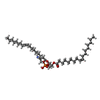 ChemComp-PEE: |
-Macromolecule #3: (2S)-1-{[(S)-hydroxy{[(1s,2R,3R,4R,5S,6S)-2,3,4,5,6-pentahydroxyc...
| Macromolecule | Name: (2S)-1-{[(S)-hydroxy{[(1s,2R,3R,4R,5S,6S)-2,3,4,5,6-pentahydroxycyclohexyl]oxy}phosphoryl]oxy}-3-(octadecanoyloxy)propan-2-yl (5E,8E,11E,14E)-icosa-5,8,11,14-tetraenoate type: ligand / ID: 3 / Number of copies: 1 / Formula: EIJ |
|---|---|
| Molecular weight | Theoretical: 887.128 Da |
| Chemical component information | 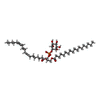 ChemComp-EIJ: |
-Macromolecule #4: CHOLESTEROL
| Macromolecule | Name: CHOLESTEROL / type: ligand / ID: 4 / Number of copies: 22 / Formula: CLR |
|---|---|
| Molecular weight | Theoretical: 386.654 Da |
| Chemical component information |  ChemComp-CLR: |
-Experimental details
-Structure determination
| Method | cryo EM |
|---|---|
 Processing Processing | single particle reconstruction |
| Aggregation state | particle |
- Sample preparation
Sample preparation
| Concentration | 0.3 mg/mL |
|---|---|
| Buffer | pH: 8 |
| Vitrification | Cryogen name: ETHANE / Chamber humidity: 100 % / Chamber temperature: 277 K / Instrument: FEI VITROBOT MARK IV |
- Electron microscopy
Electron microscopy
| Microscope | TFS KRIOS |
|---|---|
| Image recording | Film or detector model: GATAN K3 (6k x 4k) / Average electron dose: 40.0 e/Å2 |
| Electron beam | Acceleration voltage: 300 kV / Electron source:  FIELD EMISSION GUN FIELD EMISSION GUN |
| Electron optics | Illumination mode: OTHER / Imaging mode: OTHER / Nominal defocus max: 2.5 µm / Nominal defocus min: 1.5 µm |
| Experimental equipment |  Model: Titan Krios / Image courtesy: FEI Company |
+ Image processing
Image processing
-Atomic model buiding 1
| Refinement | Space: REAL / Protocol: AB INITIO MODEL |
|---|---|
| Output model |  PDB-7she: |
 Movie
Movie Controller
Controller



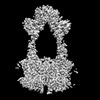


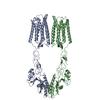

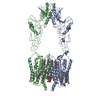

 Z (Sec.)
Z (Sec.) Y (Row.)
Y (Row.) X (Col.)
X (Col.)





















